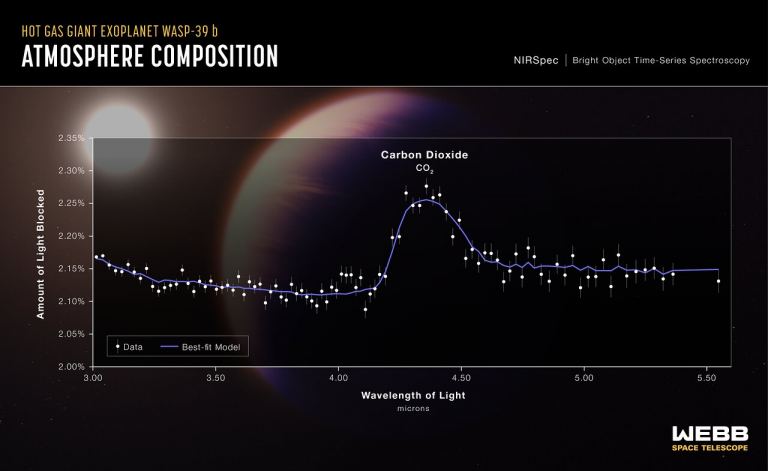LIFE telescope concept passes first test, detecting signs of life on Earth

We know of the existence of thousands of exoplanets, and millions more are waiting to be discovered. But the vast majority of exoplanets are simply uninhabitable. The few that may be suitable for life can only be determined by studying their atmospheres. LIFE can help with this – Large Interferometer for Exoplanets (“Large Exoplanet Interferometer”).
The search for biosignatures on potentially habitable exoplanets is gaining momentum. Webb has successfully collected several spectra of exoplanet atmospheres, but it has a lot of other work to do and observing time is at a premium. A planned space telescope called LIFE is designed to search for biosignatures of exoplanets, and researchers recently put it to the test: Can it detect Earth's biosignatures?
As an interferometer, LIFE consists of five separate telescopes that will work in unison to increase the effective size of the telescope. LIFE is being developed by the Federal Institute of Technology Zurich (ETH Zurich) in Switzerland. LIFE will observe in the mid-infrared region, where the spectral lines of important bioindicator chemicals such as ozone, methane and nitrous oxide are found.
LIFE will be located at Lagrange Point 2, about 1.5 million km (1 million miles) away, where Webb is located. From this place, he will observe a whole list of exoplanets in the hope of finding biosignatures on them. “Our goal is to detect chemical compounds in the light spectrum that hint at life on exoplanets,” explains Sascha Kuantz, professor in the Department of Exoplanets and Habitability at Zurich Institute of Technology, who leads the LIFE initiative.

LIFE is still in the concept stage, and the researchers wanted to test its functionality. Since it hasn't been built yet, the team used Earth's atmosphere as a test sample. They treated Earth as an exoplanet and tested LIFE's methods against the known spectrum of Earth's atmosphere under different conditions. To work with the data, they used a tool called LIFEsim. Researchers often use simulated data to test mission capabilities, but in this case they used real data.
results The research was published in The Astronomical Journal. The study is called “Large Interferometer for Exoplanets (LIFE) XII. Detectability of captan biosignatures in the mid-infrared – a sniff for exoplanetary laughing gas and methylated halogens.” Lead author is Dr. Daniel Angerhausen, an astrophysicist and astrobiologist at ETH Zurich.
In a real scenario, a planet like Earth would be just a distant, almost indistinguishable speck. All LIFE will see is the planet's atmospheric spectrum, which will change over time depending on what images the telescope takes and, crucially, how long it follows the selected planet.
These spectra will be collected over time, which leads to an important question: How will observing geometry and seasonal variations affect LIFE observations?
Luckily for the research team, we have plenty of Earth observations to work with. The researchers worked with three different observing geometries: two views from the poles and one from the equatorial region. Based on these three observation points, they worked with atmospheric data for January and July, which account for the greatest seasonal variations.
Although planetary atmospheres can be extremely complex, astrobiologists focus on certain aspects to identify a planet's potential to host life. The chemicals of particular interest are N20, CH3Cl and CH3Br (nitrous oxide, chloromethane and bromomethane), all of which can be released into the atmosphere through biological processes. “We use a set of scenarios derived from chemical kinetics models that simulate the atmospheric response to varying levels of biogenic production of N2O, CH3Cl and CH3Br in the O2-rich atmospheres of terrestrial planets to generate promising models for our observational simulation software LIFEsim,” they write. authors.
Specifically, the researchers wanted to see if LIFE could detect CO2, water, ozone and methane on planet Earth from a distance of about 30 light years. These are signs of a temperate, life-sustaining world—especially ozone and methane, which are produced by life on Earth. If LIFE can detect biological chemistry on Earth in this way, then it can detect it on other worlds as well.
LIFE was able to detect CO on Earth2, water, ozone and methane. He also discovered some surface conditions that indicate the presence of liquid water. Interestingly, LIFE's results do not depend on the angle at which the Earth is viewed. This is important because we don't know at what angle LIFE will observe exoplanets.
Another problem is seasonal variations, which were not easy to observe. But fortunately, it doesn't look like this will be the limiting factor. “Even if atmospheric seasonality is not easily observed, our study shows that the next generation of space missions could assess whether nearby temperate Earth exoplanets are habitable or even habitable,” Kuantz says.
However, simply detecting the right chemicals is not enough. The most important thing is how long it will take. Building a space interferometer that would detect these chemicals but would take too much time would be impractical and ineffective. “We use the results to determine the observation time required to detect these scenarios and apply them to determine the science requirements for the mission,” the research team wrote in their paper.
To get a more complete picture of the timing of LIFE observations, the researchers compiled a list of targets. They compiled “…a distribution of distances between HZ planets with radii ranging from 0.5 to 1.5 Earth radii around M and FGK stars within 20 pc of the Sun that can be detected by LIFE.” Data for these purposes come from NASA and other previous studies.

The results show that some targets require only a few days, while others may require up to 100 days to detect sufficient amounts of the substance in the atmospheric spectrum.
What the team calls “golden targets” are the easiest to observe. The planets in Proxima Centauri are an example of such targets. Such planets require only a few days of observations. Observing “some standard scenarios, such as temperate, terrestrial planets around M-class host stars at a distance of five pc,” would require about ten days of LIFE observations, the researchers wrote. The most difficult cases that are still feasible are exoplanets that are twins of Earth at a distance of about 5 parsecs. According to the results obtained, it will take 50 to 100 days of observations to detect LIFE biosignatures.
For now, LIFE remains only a potential mission. This is not the first proposed mission that will be aimed solely at studying the habitability of exoplanets. In 2023, NASA proposed the creation of a Habitable Worlds Observatory (HWO). Its goal is to obtain direct images of at least 25 potentially habitable worlds, and then search for biosignatures in their atmospheres.
But the authors say their results suggest that LIFE is a better option.
“If late-type exoplanet star systems with planets exist in the solar neighborhood that exhibit global biospheres producing N2O and CH3X signals, then LIFE would be the best future mission to systematically search for them and subsequently detect them,” they conclude.





